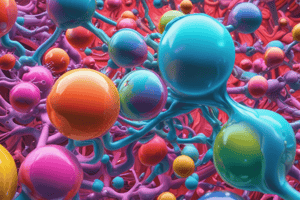Podcast
Questions and Answers
The formula for Ficks law of diffusion is: J = -D(dC/dx), where J is the diffusion flux, D is the diffusion coefficient, and (dC/dx) is the concentration ______.
The formula for Ficks law of diffusion is: J = -D(dC/dx), where J is the diffusion flux, D is the diffusion coefficient, and (dC/dx) is the concentration ______.
gradient
Ficks law of diffusion states that the rate of ______ is directly proportional to the concentration gradient and the cross-sectional area, and inversely proportional to the distance.
Ficks law of diffusion states that the rate of ______ is directly proportional to the concentration gradient and the cross-sectional area, and inversely proportional to the distance.
diffusion
Ficks law of diffusion is commonly used to describe the movement of molecules in gases and ______.
Ficks law of diffusion is commonly used to describe the movement of molecules in gases and ______.
liquids
Flashcards are hidden until you start studying
Study Notes
Fick's Law of Diffusion
- The formula for Fick's law of diffusion is: J = -D(dC/dx), where J is the diffusion flux, D is the diffusion coefficient, and (dC/dx) is the concentration gradient.
- Fick's law of diffusion states that the rate of diffusion is directly proportional to the concentration gradient and the cross-sectional area, and inversely proportional to the distance.
- Fick's law of diffusion is commonly used to describe the movement of molecules in gases and liquids.
Studying That Suits You
Use AI to generate personalized quizzes and flashcards to suit your learning preferences.




